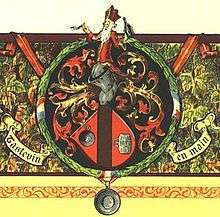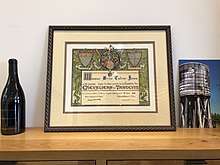Confrérie des Chevaliers du Tastevin
The Confrérie des Chevaliers du Tastevin (English: "Fraternity of Knights of the Wine-Tasting Cup") is an exclusive bacchanalian fraternity of Burgundy wine enthusiasts.[2] It was founded in 1934.[3] It is headquartered at the 12th century Château of Clos de Vougeot in the Côte d'Or region of France. It maintains chapters worldwide, called Sous-Commanderies, but because of its Gallic origins, its name and many of its ceremonial titles are always maintained in French.
 Coat of arms of Confrerie des Chevaliers du Tastevin, depicted as a crest on a wall, a 16th-century cartoon priest-chevalier. | |
| Motto | French: Celui-là n'est pas bon qui ne cherche à devenir meilleur[1] ("He is not good, who strives not to be better") - Saint Bernard |
|---|---|
| Formation | 1703; revived 1934 |
| Type | Bacchanalian fraternity |
| Headquarters | Château of Clos de Vougeot |
| Location |
|
Membership | 12,000[1] |
Official language | French |
| Website | www |
Formerly called | Ordre de la Boisson ("Order of the Beverage") |
History
The Confrérie, as it exists today, was founded in 1934. Its origins come from the earlier Order of the Free Drinkers of Burgundy. The initial idea was to reinvigorate the wine industry in the region during the economic turmoil of the mid-century. The first Chapitre was held on 16 November 1934 in the Caveau Nuiton cellar in Nuits-Saint-Georges.[4][5]
The American branch was created on 27 March 1940 in New York by Jules Bohy (Washington DC opened in 1946).[6][4]
In 1944, the founders of the Confrérie bought the Château of Clos de Vougeot, made it its headquarters, and started a long renovation process.[6]
Organization
The Confrérie is governed by a Grand Conseil of Chevaliers. Its president is called the Grand-maître and its secretary is called the Grand Connétable (Louis-Marc Chevignard[4]). In the USA, the organization delegates authority to a Grand pilier, who is also assisted by a Grand connétable. Candidates for membership are approved by the Grand pilier or Grand connétable, and are confirmed by the Grand Conseil. New members are knighted with a petrified grapevine root from Burgundy.[6]
Members are hierarchically ranked (in descending order) as Grand officier, Officier-commandeur, Commandeur, and Chevalier. The Confrérie counts among its membership businessmen, luminaries, and celebrities, including politicians and military leaders, diplomats, executives, scholars, athletes, musicians, and artists. During initiation ceremonies, members wear ornate robes similar to the academic gowns worn by Doctors of Theology in sixteenth-century France.
During the knight induction process, the following sentence is pronounced : French: Par Noé, Père de la Vigne, Par Bacchus, Dieu du Vin, Par Saint-Vincent, Patron des Vignerons, Nous vous armons Chevalier du Tastevin (Through Noah, father of vines, Bacchus, god of wine, Saint-Vincent, patron of winemakers, We make you Knight of Tastevin).[7]
The primary aims of the organisation are "to hold in high regard and promote Burgundian produce, particularly her great wines and regional cuisine. To maintain and revive the festivities, customs and traditions of Burgundian folklore," and "to encourage people from all over the world to visit Burgundy."[8]
In 2016, the membership was around 12,000 worldwide (2,300 in the USA alone).[4][5] The confrérie accepts men and women. There are 33 Chapitres in the USA.[6]
Activities

The organization's activities are generally scheduled around elaborate chapter dinners and other culinary events, at which Burgundian wines are served (although sometimes other quality French wines are sampled). At these events, it is customary for members to comment in detail about the history and characteristics of each wine or dish that is served, in order to promote "viticultural and gastronomic education".[9]
Each Chapitre collects and stores its own wine, with one member assigned to the cellar.[6]
The most important annual event of the Confrérie is the tasting of Burgundy wines, called "Tastevinage", at the Château de Vougeot, where those deemed worthy by a jury of tasters are awarded the title of "Tasteviné" and are permitted to use a special label on their bottles.[5]
The Confrérie publishes its official magazine twice a year, Tastevin en Main.[4]
Famous members
Bibliography
- Jean-Francois Bazin, Bernard Pivot, Confrerie des Chevaliers du Tastevin: 1934 - 1994, Les Editions du Tastevin (1994)
References
- "La Confrérie des Chevaliers du Tastevin - LA CONFRÉRIE - Les chapitres". www.tastevin-bourgogne.com.
- Kamen, Al (22 May 2013). "From planes to frames". The Washington Post. Retrieved 25 May 2013.
- Laferté, Gilles (2002). "La production d'identités territoriales à usage commercial dans l'entre-deux-guerres en Bourgogne". Cahiers d'économie et de sociologie rurales. 62: 65–95.
- The Confrérie Organization, the History and Traditions, Tastevincanada.com
- Eric Grundhauser, A Look At Mr. Wonderful’s Secret Society for Wine Snobs, Atlasobscura.com, 9 February 2016
- Valerie Cruice, Fraternity gathers for love of wine, Nytimes.com, 8 June 1986
- Juliet Cullinan, Queen of the Tastevin, Julietcullinan.co.za, 21 May 2018
- Confrérie des Chevaliers du Tastevin, booklet (June 1959).
- "Dinner at the Clos de Vougeot - Articles - JancisRobinson.com". www.jancisrobinson.com.
- The World’s Most Elite Wine Groups (That You Probably Can’t Join), Lastbottlewines.com, 28 June 2018